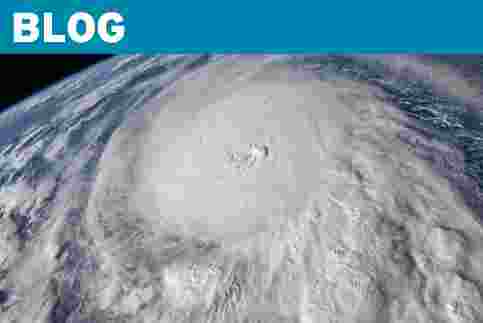Typhoon Hagibis: Japan's costliest typhoon?
Typhoon Hagibis made landfall in Japan on 12 October 2019, causing widespread flooding and damage. On 14 October, JBA’s event response team produced an initial event commentary (see below on page) as well as an event footprint. This updated event report explores the typhoon in more depth.
The storm and widespread flooding
Typhoon Hagibis carried with it a large volume of warm moisture, resulting in unprecedented rainfall across a third of Japan (Figure 1). In some areas, it was reported that approximately 30-40% of annual rainfall fell within 24 to 48 hours (Yotsumoto, 2019).
Extensive residential areas were inundated in Nagano prefecture while houses in the city of Ichihara, Chiba prefecture, were damaged by strong typhoon winds (Nochi, 2019; Olano, 2019). Across Japan, 13,000 houses were inundated and 900 were completely or partially destroyed (Yotsumoto, 2019). Industrial sites located near the Chikuma River in Nagano prefecture and Koriyama city in Fukushima prefecture were also severely inundated (Insurance Business Magazine, 2019). The shinkansen (bullet train) maintenance yard in Nagano was flooded, with 10 trains and 120 carriages reported to be damaged by floodwater (Yotsumoto, 2019). Two major Japanese airlines, All Nippon Airways (ANA) and Japan Airlines (JAL) , cancelled a total of 558 and 540 flights respectively as services were disrupted at Tokyo airports on 13 and 14 October 2019 (Asquith, 2019).
Due to Typhoon Hagibis, 85 fatalities and 9 missing people were reported at the time of writing (NHK, 2019).
Hakone town in Kanagawa prefecture (a resort town approximately 90km south-west of Tokyo) was one neighbourhood that experienced severe flooding. Within 24 hours, Hakone received a total of 922.5mm of rainfall, which is the highest volume of rainfall ever recorded in Japan over a 24-hour period (Mori, 2019). It has an estimated return period of greater than 1,500 years based on JBA’s rainfall return period data.
Similar statistical analysis of NASA radar precipitation data to calculate a rainfall return period for Nagano prefecture and Koriyama city shows that both have an estimated return period of 50 years. The greater Tokyo region has an estimated return period of approximately 1,500 years or greater (Table 1).
Table 1: Table illustrating the return period at individual locations based on 24-hour rainfall total. (Disaster Management Japan, 2019)
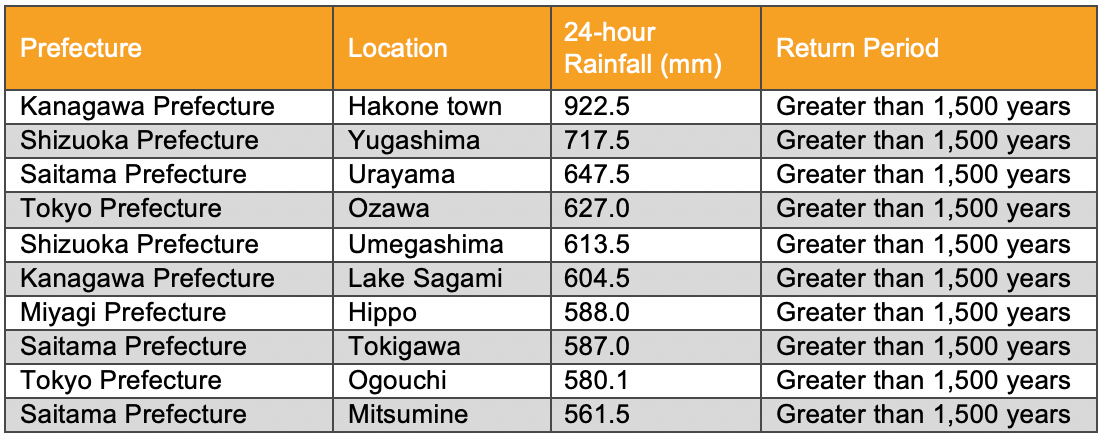
 Figure 1: Total rainfall recorded across a 4-day period between 9 October – 13 October 2019. The total rainfall is based on daily precipitation data collected by NASA’s Precipitation Measurement Missions. (Data source: NASA PPM, 2019) (JBA Risk Management Limited™)
Figure 1: Total rainfall recorded across a 4-day period between 9 October – 13 October 2019. The total rainfall is based on daily precipitation data collected by NASA’s Precipitation Measurement Missions. (Data source: NASA PPM, 2019) (JBA Risk Management Limited™)
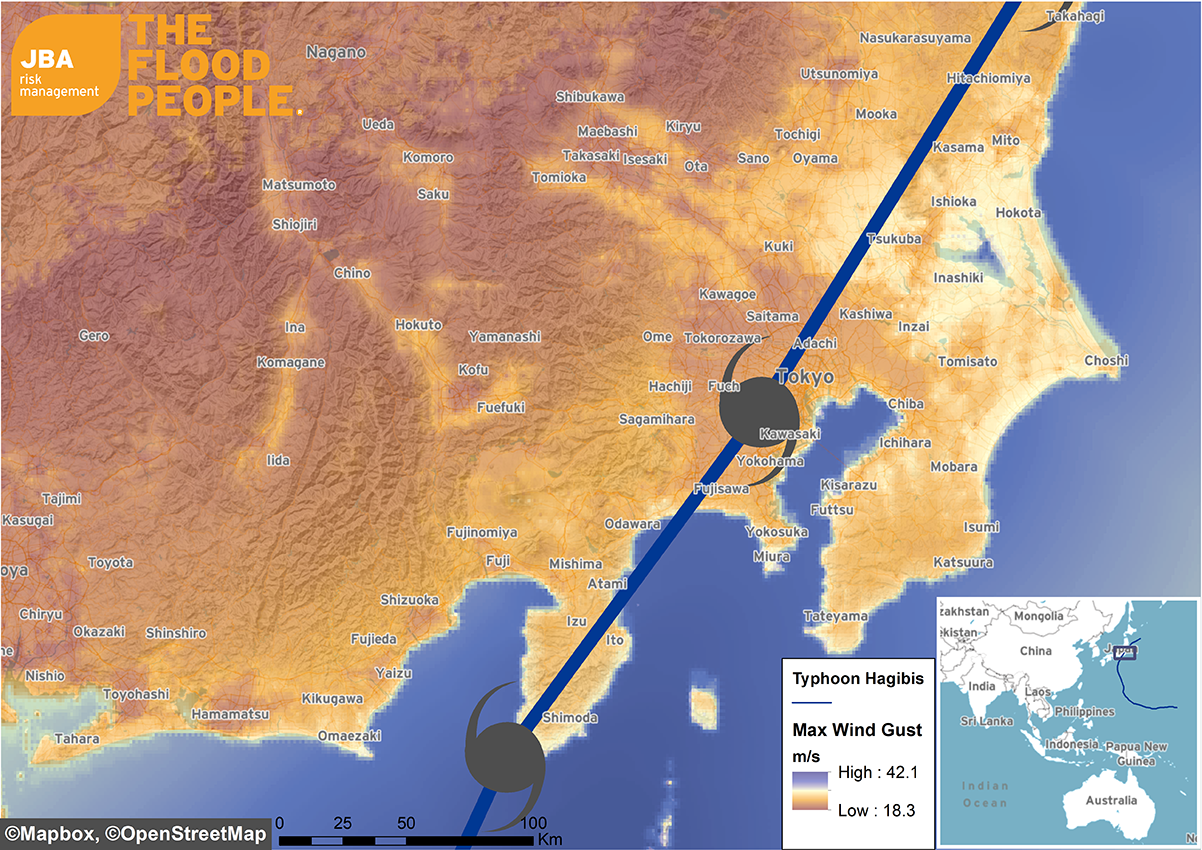 Figure 2: Wind footprint illustrates max wind gust generated using Delft 3D based on typhoon track and central pressure data. (JBA Risk Management Limited™)
Figure 2: Wind footprint illustrates max wind gust generated using Delft 3D based on typhoon track and central pressure data. (JBA Risk Management Limited™)
Impacts for insurers
Insurance losses for Hagibis remain uncertain at the moment; however, severe damages were reported across 13 prefectures.
As a result, Typhoon Hagibis is likely to result in losses greater than USD $10 billion and the losses may slowly increase over the weeks to come, similar to Typhoon Jebi (Artemis BM, 2019). Insured losses due to Typhoon Jebi, which hit Osaka directly last year, have since passed the USD $10 billion mark. In early May 2019, it was reported that the industry loss caused by Jebi was approximately USD $13 billion and may even increase to USD $16 billion (Evans, 2019a and 2019b). One of the reasons for the high losses from Typhoon Jebi was the close proximity in time between Typhoon Jebi and Typhoon Trami (Evans, 2019a).
The total losses from Typhoon Hagibis and Faxai (which occurred earlier in September 2019) are likely to be comparable to these two large typhoon events which hit Japan in 2018, totalling USD $18 billion (Artemis BM, 2019).
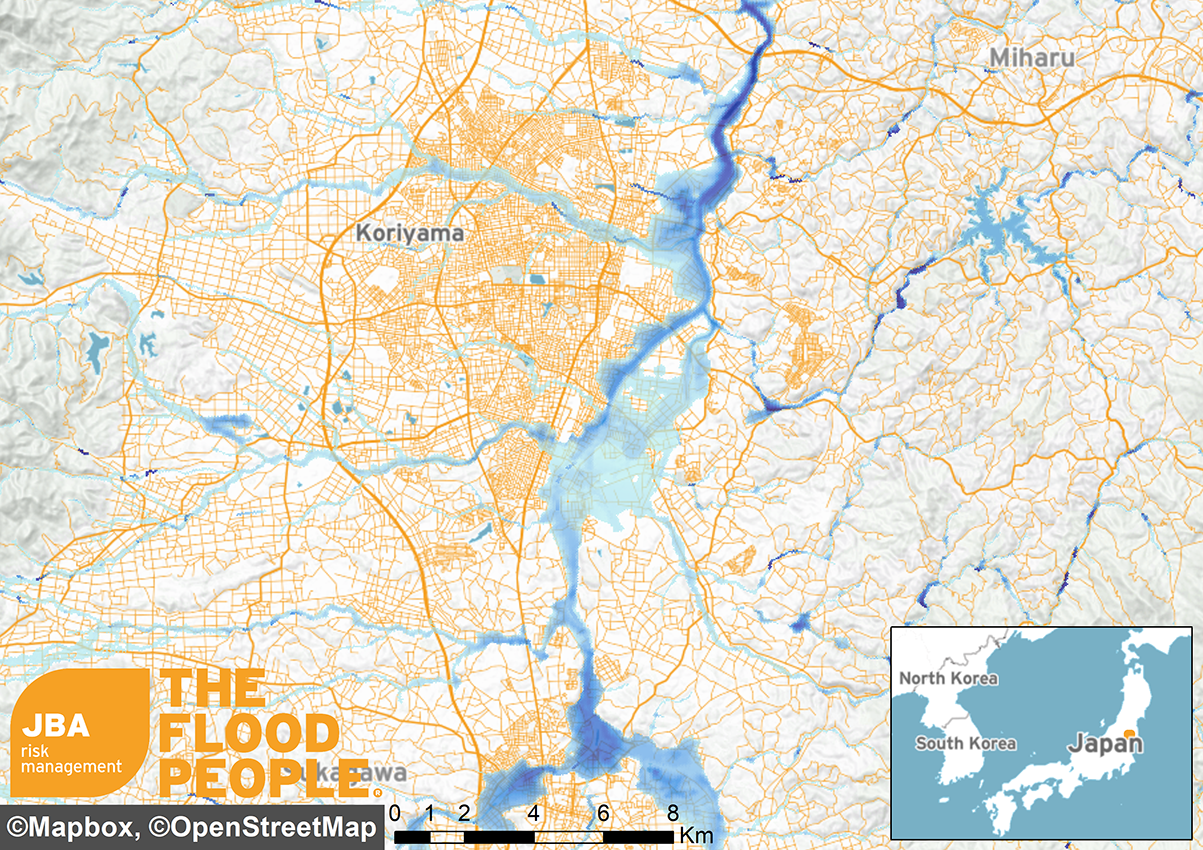 Figure 3: JBA’s flood footprint for Typhoon Hagibis based on JBA’s Japan 30m flood maps. The area in view is Koriyama, in Fukushima prefecture with the Abukuma River running through it (JBA Risk Management Limited™)
Figure 3: JBA’s flood footprint for Typhoon Hagibis based on JBA’s Japan 30m flood maps. The area in view is Koriyama, in Fukushima prefecture with the Abukuma River running through it (JBA Risk Management Limited™)
Why did Hagibis cause severe damages?
According to reports, Hagibis has been one of the strongest tropical systems globally this summer. As the weather system crossed the warm waters near the Mariana Islands, to the south-east of Japan, the typhoon intensified rapidly, with the pressure at the centre of the typhoon decreasing from 992hPa to 915hPa within 24 hours (Mori, 2019). Based on historical track data, typhoons which passed through this warm water before reaching Japan are likely to result in damages with a greater severity, due to the warm water strengthening the typhoon and allowing it to carry more warm moisture towards Japan.
Additionally, there are no land masses nearby to dissipate the strength of the typhoon before reaching Japan.
The severity of Hagibis’ damage can also be understood in the context of the typhoon’s size – Typhoon Hagibis was a large typhoon, with a diameter of around 1,400km (Mori, 2019). This size meant that heavy rainfall had begun in several prefectures in Japan before Hagibis made landfall near Izu Peninsular. Hagibis then made slow progress, with a forward moving velocity of 30kph, meaning the typhoon lingered longer over the land mass and resulted in a high accumulation of rainfall in several regions (Mori, 2019).
The effects of Typhoon Hagibis may worsen as two more storm systems are likely to approach Japan in the coming days. First is Typhoon Neoguri, a former category 2 storm and now an extratropical cyclone as classified by the Japan Meteorological Agency. Neoguri may result in heavy rainfall near Ise and Mikawa bays, in previously-hit Hakone and Tokyo, and in China. Bualoi is the second to follow and is predicted to have a close encounter with south-east Japan. However, it is too early to understand the severity of rainfall and possible floods.
Historical typhoon events
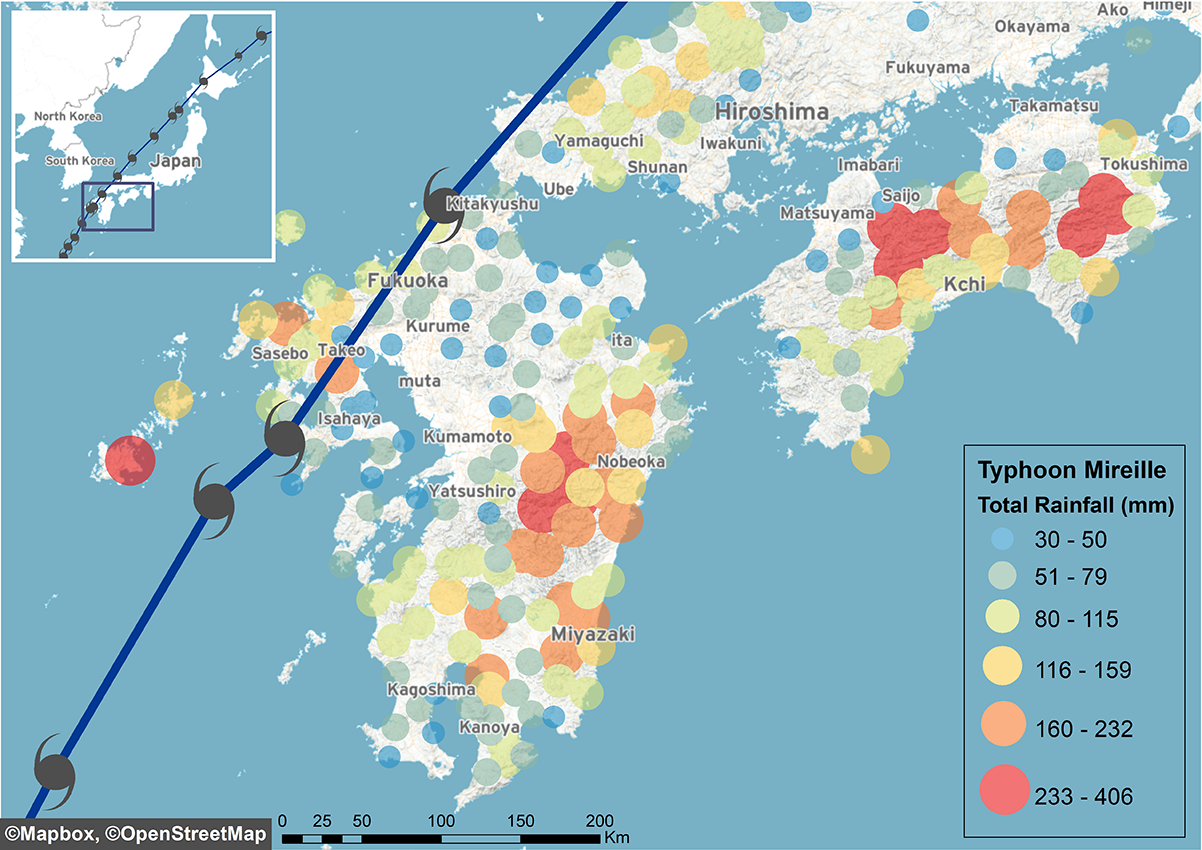 Figure 4: Total rainfall accumulation during Typhoon Mireille, which made landfall near Nagasaki in the south-west of Japan on 27 September 1991. South of Japan and Hokkaido Island received the greatest amount of rainfall as the Typhoon made landfall first near Fukuoka and for a second time in Hokkaido (please refer to insert).(Data source: National Institute of Informatics, 2019) (JBA Risk Management Limited™)
Figure 4: Total rainfall accumulation during Typhoon Mireille, which made landfall near Nagasaki in the south-west of Japan on 27 September 1991. South of Japan and Hokkaido Island received the greatest amount of rainfall as the Typhoon made landfall first near Fukuoka and for a second time in Hokkaido (please refer to insert).(Data source: National Institute of Informatics, 2019) (JBA Risk Management Limited™)
Typhoon Hagibis may be on track to be one of the costliest typhoons affecting Japan. To date, the costliest typhoon in Japan was Typhoon Mireille, which made landfall in 1991 near Nagasaki in Kyushu Island (Figure 4), at the south of Japan with wind speeds of up to 185kph (115mph). The total damage was estimated to be USD $10 billion, with more than 30% of losses attributed to agricultural damage, especially in relation to the apple industry. In addition, 62 deaths were reported, with at least 170,000 houses damaged and 22,965 houses inundated (National Institute of Informatics, 2019). The total insurance payout from Typhoon Mireille was estimated to be USD $5.32 billion (Sonpo, 2019).
Ranked as the third deadliest natural disaster in Japan based on recorded data, Typhoon Vera, known as Typhoon Isewan in Japan, hit Honshu on 26 September 1959 with maximum sustained wind gusts of up to 222kph (138mph) and a central pressure of 920hPa. At the time, total damages were estimated to be USD $600 million (equivalent to USD $5.16 billion in 2018). A total of 4,697 deaths were reported with approximately 834,000 houses damaged or destroyed. All prefectures except Kyushu were affected by Typhoon Vera. (EM-DAT, 2019)
Table 2: Table illustrating past typhoon events in Japan and the respective claims made to direct insurers in Japan. The table represents the total claims from direct insurers, who are members of the General Insurance Association of Japan (GIAJ) only. Claims to foreign insurers and others are not represented in the data below. (Source: http://www.sonpo.or.jp/en/statistics/claim/)

Future outlook
In the future, climate change is likely to result in an observable increase in the intensity of hurricanes and typhoons (Normille, 2019). In addition, several major cities in Japan, including Nagoya, Osaka and Tokyo are now located below sea level, causing them to be vulnerable to stronger storms and typhoons of higher intensities (Normille, 2019). To mitigate impacts from future storms, it will be crucial to invest in engineering methods and disaster management measures such as evacuation planning.
JBA Risk Management has nationwide return period flood maps and a flood model for Japan at 30m resolution. We have also produced an updated flood footprint for the typhoon, estimating extents and depths from river flooding.
Please get in touch for more information on how we can help you manage your risk.
Event commentary - 14 October 2019
On Saturday 12 October 2019, Typhoon Hagibis made landfall in Japan’s Izu Peninsula, south-west of Tokyo, shortly before 19:00 JST (10:00 GMT) (BBC News, 2019a). Hagibis, the nineteenth typhoon of the season in Japan, caused widespread flooding and landslides (Japan Times, 2019a).
Moving up the eastern coast of Japan’s main island, Honshu, and impacting eight prefectures across the island, Typhoon Hagibis was the worst storm to hit the country in 60 years with torrential rain and wind speeds of 225kph (140mph) – equivalent to a Category 2 hurricane on the Saffir-Simpson scale (BBC News, 2019a; BBC News, 2019b; Watchers, 2019). Hagibis underwent the most rapid intensification of any tropical cyclone in the western Pacific in at least 23 years, becoming a major hurricane-level typhoon in just six hours (Watchers, 2019). It follows Typhoon Faxai which hit Japan last month.
During the approach of the typhoon, over seven million people were recommended to evacuate, although only 50,000 are thought to have followed the advice (BBC News, 2019a). Many trains and metro lines were suspended, with all flights to and from Haneda and Narita airports cancelled ahead of the typhoon’s landfall (BBC News, 2019d). Several landslides occurred before the typhoon made landfall, causing at least two deaths, and a 5.7 magnitude earthquake affected Chiba, east of Tokyo, on Saturday evening just before Hagibis hit (The New York Times, 2019).
The effects
Heavy rain caused water levels to rise along several major rivers, including the Arakawa, Chikuma and Tama rivers (Japan Times, 2019a; BBC News, 2019d). At least 142 rivers have flooded, with Japan’s Ministry of Land, Infrastructure, Transport and Tourism confirming the collapse of levees at 10 locations on nine rivers , as well as 48 landslides and mudflows in 12 prefectures (NHK, 2019a; Watchers, 2019; The New York Times, 2019).
Nagano prefecture is amongst the worst affected by flooding, with several levees along the Chikuma river breaching (BBC News, 2019a). Some residential areas were estimated to be under 5m (16.4ft) of water following the river’s breach (Watchers, 2019). A train depot in Nagano was severely flooded, causing 10 high-speed trains to be submerged; each train has been valued at $30 million (BBC News, 2019a).
Record-breaking rainfall also occurred in the town of Hakone, with more than a metre (3ft) of rain falling in 48 hours, the highest total ever recorded in Japan in that timeframe (BBC News, 2019a). Several other areas received 30% to 40% of the average annual rainfall in just 48 hours (Watchers, 2019).
Although the typhoon has now weakened and moved back out to sea, at the time of writing Hagibis has caused an estimated 43 fatalities, with 16 people still missing (Bloomberg, 2019). Among the fatalities are at least five crew members of a boat that sunk in Tokyo Bay on Saturday (ABC News, 2019).
More than 110,000 people are taking part in search and rescue operations across Japan, including 27,000 military troops and rescue crews (BBC News, 2019a; BBC News, 2019b). Around 92,000 households remain without power, although more than 360,000 households were originally cut off on Sunday 13 October (BBC News, 2019a; The New York Times, 2019). Around 120,000 households are experiencing water outages (BBC News, 2019a).
The typhoon may be Japan’s second-costliest storm and insurance claims may reach $5 billion to $10 billion, although it is too early to tell at the time of writing (Bloomberg, 2019).
JBA event response
Our event response team has produced a flood footprint estimating flood extents and depths across the area affected to help businesses understand the potential impacts. Please get in touch for more information or to request the footprint.
References
Event report - 24 October 2019
Asquith, J. (2019). The Century’s Strongest Super-Typhoon Hagibis Is About To Hit Japan—1,600 Flights Canceled. [online] Forbes.com. Available at: https://www.forbes.com/sites/jamesasquith/2019/10/11/the-centurys-strongest-super-typhoon-hagibis-is-about-to-hit-japan1600-flights-cancelled/#74421011676c [Accessed 24 Oct. 2019].
Dooley, B., Inoue, M. and Yamamitsu, E. (2019). Japan Spent Mightily to Soften Nature’s Wrath, but Can It Ever Be Enough?. New York Times. [online] Available at: https://www.nytimes.com/2019/10/16/world/asia/japan-typhoon-hagibis.html [Accessed 24 Oct. 2019].
Disaster Management Japan, (2019). [pdf] Disaster Management Japan. Available at: http://www.bousai.go.jp/updates/r1typhoon19/pdf/r1typhoon19_05.pdf [Accessed 24 Oct. 2019].
EM-DAT. (2019). EM-DAT | The international disasters database. [online] Available at: https://www.emdat.be/index.php [Accessed 24 Oct. 2019].
Artemis.bm, S. (2019). Jebi nears $13bn, why industry missed the loss creep. [online] Artemis BM. Available at: https://www.artemis.bm/news/jebi-nears-13bn-why-industry-missed-the-loss-creep-swiss-re-cfo/ [Accessed 24 Oct. 2019].
Evans, S. (2019b).Typhoon Jebi industry loss may settle at $15bn to $16bn: Analysts - Artemis.bm. [online] Artemis BM. Available at: https://www.artemis.bm/news/typhoon-jebi-industry-loss-may-settle-at-15bn-to-16bn-analysts/ [Accessed 24 Oct. 2019].
Insurance Business Mag, 2019. [online] Insurance Business. Available at: https://www.insurancebusinessmag.com/asia/news/breaking-news/crawford-releases-update-on-typhoon-hagibis-damage-in-japan-180489.aspx [Accessed 24 Oct. 2019].
Hoffman, R. (2019). 1959 Annual Typhoon Report. [ebook] Joint Typhoon Centre. Available at: https://www.usno.navy.mil/NOOC/nmfc-ph/RSS/jtwc/atcr/1959atcr.pdf [Accessed 24 Oct. 2019].
Kahn, B. (2019). Typhoon Hagibis Is Japan's Latest Multi-Billion-Dollar Disaster. [online] Earther. Available at: https://earther.gizmodo.com/typhoon-hagibis-is-japans-latest-multi-billion-dollar-d-1839031449 [Accessed 24 Oct. 2019].
Mori, S. (2019). Why did Typhoon Hagibis shatter Japan's rainfall records?. NHK (Japan Broadcasting Corporation). [online] Available at: https://www3.nhk.or.jp/nhkworld/en/news/backstories/714/ [Accessed 24 Oct. 2019].
National Institute of Informatics. (2019). Digital Typhoon: Typhoon 199119 (MIREILLE) - Disaster Information. [online] Available at: http://agora.ex.nii.ac.jp/cgi-bin/dt/dsummary.pl?id=199119&basin=wnp&lang=en [Accessed 24 Oct. 2019].
National Institute of Informatics. (2019). Digital Typhoon: Typhoon Images and Information - National Institute of Informatics. [online] Available at: http://agora.ex.nii.ac.jp/digital-typhoon/index.html.en [Accessed 24 Oct. 2019].
NASA PPM. 2019. NASA Precipitation Measurement Missions. [online] Available at: https://pmm.nasa.gov/data-access/pps-ftp#jsimpson-NRTPUB/imerg/gis/early [Accessed 24 Oct. 2019].
NHK (Japan Broadcasting Corporation) (2019). Typhoon Hagibis aftermath. [online] Available at: https://www3.nhk.or.jp/nhkworld/en/news/special/01/1919/ [Accessed 24 Oct. 2019].
Nochi, H. (2019). Nagano picking up the pieces after Typhoon Hagibis. NHK (Japan Broadcasting Corporation). [online] Available at: https://www3.nhk.or.jp/nhkworld/en/news/backstories/716/ [Accessed 24 Oct. 2019].
Normile, D. (2019). Deadly typhoon forces Japan to face its vulnerability to increasingly powerful storms. [online] Science | AAAS. Available at: https://www.sciencemag.org/news/2019/10/deadly-typhoon-forces-japan-face-its-vulnerability-increasingly-powerful-storms [Accessed 24 Oct. 2019].
Sonpo. (2019). [online] Available at: http://www.sonpo.or.jp/news/statistics/disaster/ [Accessed 24 Oct. 2019].
South China Morning Post (2019). Areas hit by Typhoon Hagibis brace for more floods as heavy rain falls in Japan. [online] Available at: https://www.scmp.com/news/asia/east-asia/article/3033722/areas-hit-typhoon-hagibis-brace-more-floods-heavy-rain-falls [Accessed 24 Oct. 2019].
Yotsumoto, J. (2019). The trail of destruction left by Typhoon Hagibis. NHK (Japan Broadcasting Corporation). [online] Available at: https://www3.nhk.or.jp/nhkworld/en/news/backstories/712/ [Accessed 24 Oct. 2019].
Event commentary - 14 October 2019
ABC News. 2019. Over 110,000 join military-led rescue effort as Japan reels from Typhoon Hagibis. [online] 14 October 2019. Available at: https://www.abc.net.au/news/2019-10-14/japan-launches-massive-rescue-mission-after-typhoon-hagibis/11601488 [14 October 2019]
BBC News. 2019a. Typhoon Hagibis: Japan deploys 110,000 rescuers after worst storm in decades. [online] 14 October 2019. Available at: https://www.bbc.co.uk/news/world-asia-50037907?intlink_from_url=https://www.bbc.co.uk/news/topics/c0w243r00vgt/typhoon-hagibis&link_location=live-reporting-story [14 October 2019]
BBC News. 2019b. Typhoon Hagibis: Rescuers deployed in wake of deadly storm. [online] 13 October 2019. Available at: https://www.bbc.co.uk/news/av/world-asia-50034490/typhoon-hagibis-rescuers-deployed-in-wake-of-deadly-storm?intlink_from_url=https%3A%2F%2Fwww.bbc.co.uk%2Fnews%2Ftopics%2Fc0w243r00vgt%2Ftyphoon-hagibis&link_location=live-reporting-map [14 October 2019]
BBC News. 2019c. Typhoon Hagibis: Japan deploys military rescuers as deadly storm hits. [online] 13 October 2019. Available at: https://www.bbc.co.uk/news/world-asia-50032170?intlink_from_url=https://www.bbc.co.uk/news/topics/c0w243r00vgt/typhoon-hagibis&link_location=live-reporting-story [14 October 2019]
BBC News. 2019d. Typhoon Hagibis: Japan suffers deadly floods and landslides from storm. [online] 13 October 2019. Available at: https://www.bbc.co.uk/news/world-asia-50020108?intlink_from_url=https://www.bbc.co.uk/news/topics/c0w243r00vgt/typhoon-hagibis&link_location=live-reporting-story [14 October 2019]
Bloomberg. 2019. Japan Sends in 110,000 Rescuers as Typhoon Death Toll at 43. [online] 13 October 2019. Available at: https://www.bloomberg.com/news/articles/2019-10-13/four-dead-and-17-missing-as-powerful-typhoon-slams-japan [14 October 2019]
Japan Times. 2019. In Pictures: The chaotic aftermath of Typhoon Hagibis. [online] 13 October 2019. Available at: https://www.japantimes.co.jp/news/2019/10/13/national/photo-gallery-typhoon-hagibis/#.XaRSwFVKhhF [14 October 2019]
The New York Times. 2019. Helicopters and Boats Rescue the Stranded After Typhoon Hits Japan. [online] 12 October 2019. Available at: https://www.nytimes.com/2019/10/12/world/asia/japan-typhoon-hagibis-dead.html [14 October 2019]
NHK. 2019. Collapse of 10 levees confirmed after Hagibis. [online] 13 October 2019. Available at: https://www3.nhk.or.jp/nhkworld/en/news/20191013_57/ [14 October 2019]
Watchers. 2019. Widespread floods after extreme rainfall brought by Typhoon Hagibis – dozens dead or missing, Japan. [online] 13 October 2019. Available at: https://watchers.news/2019/10/13/typhoon-hagibis-casualties-damage/ [14 October 2019]
